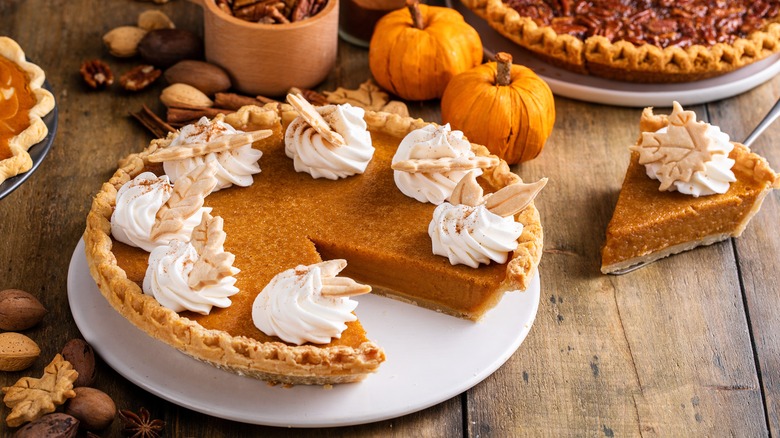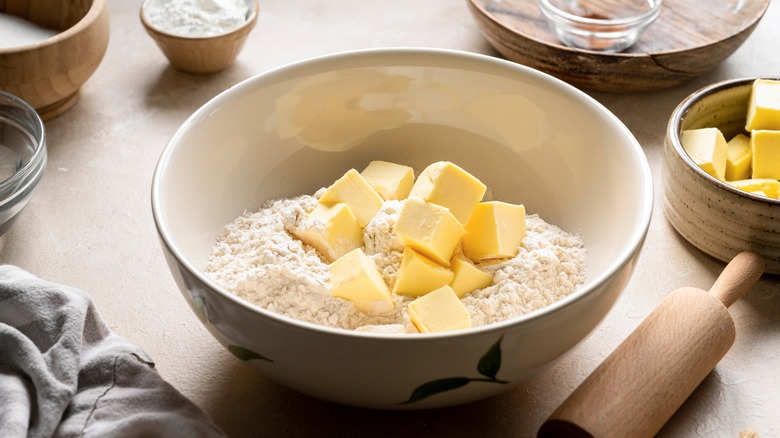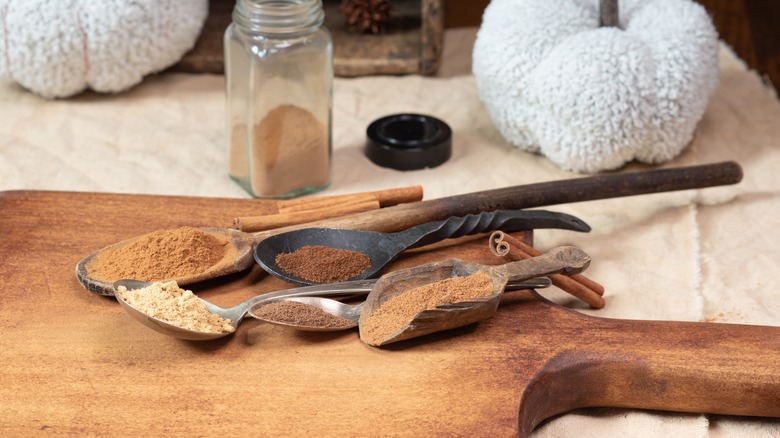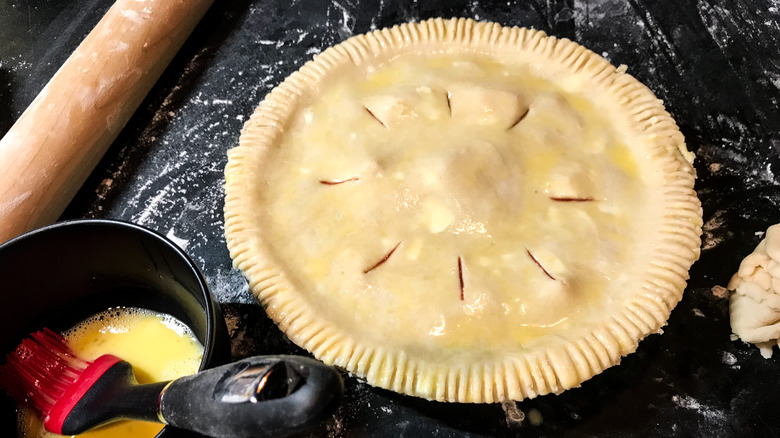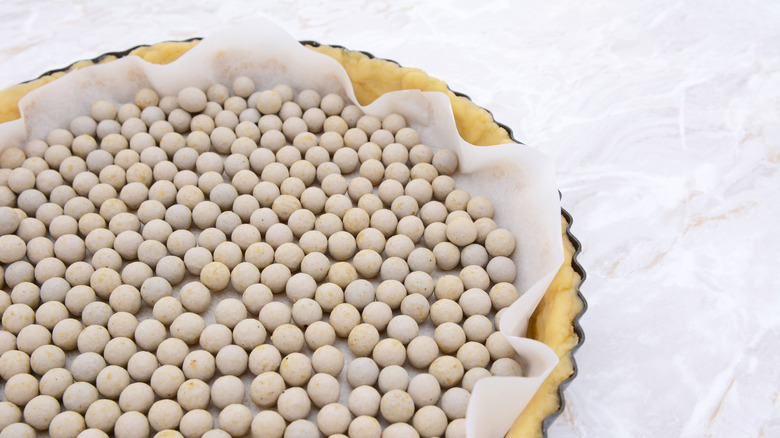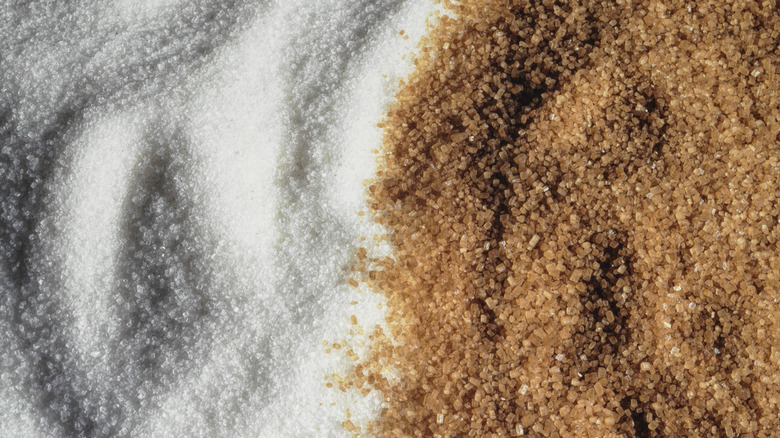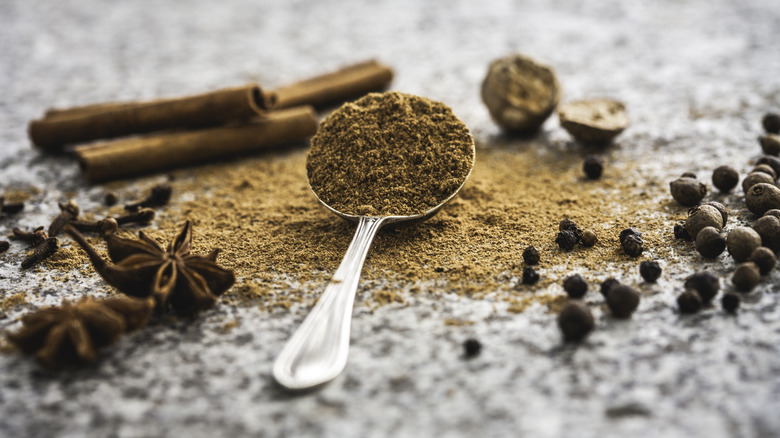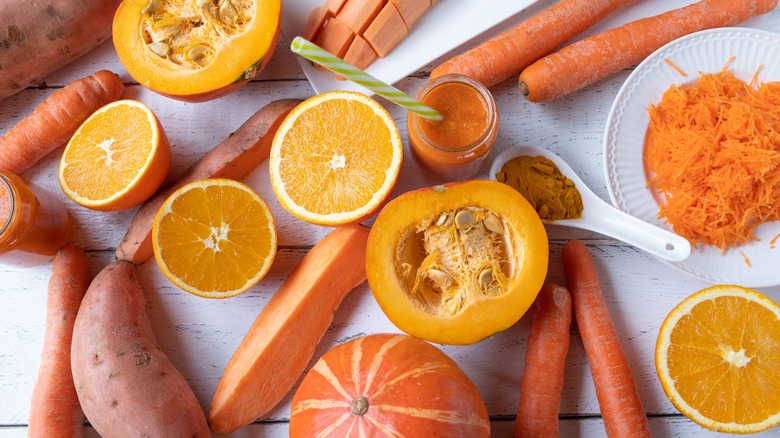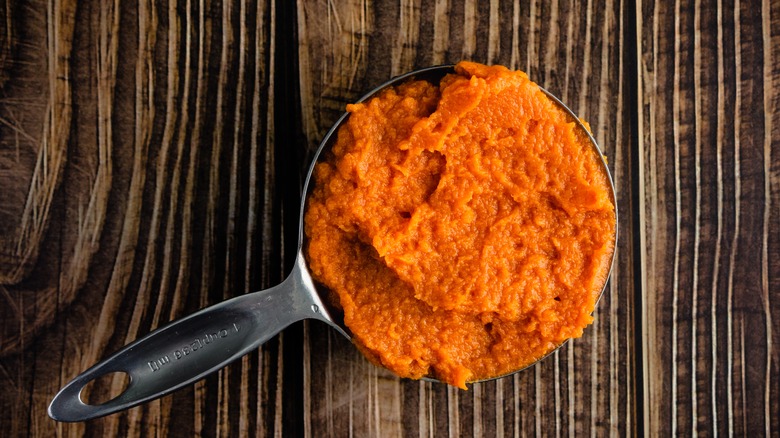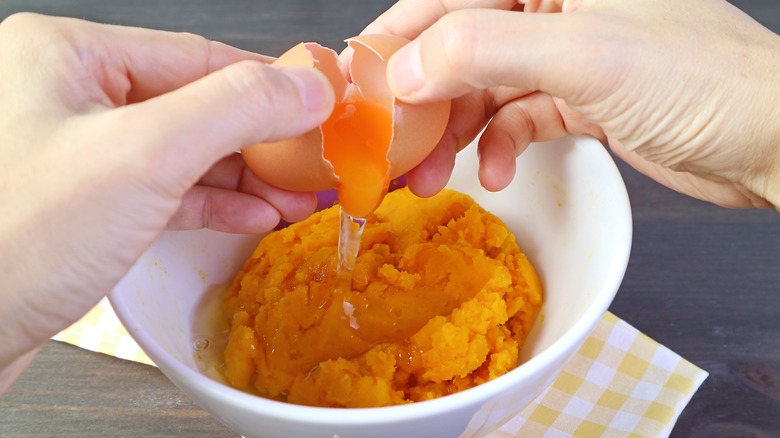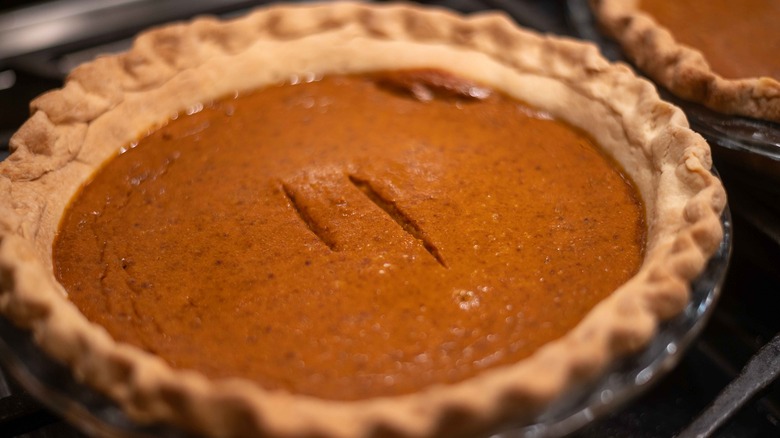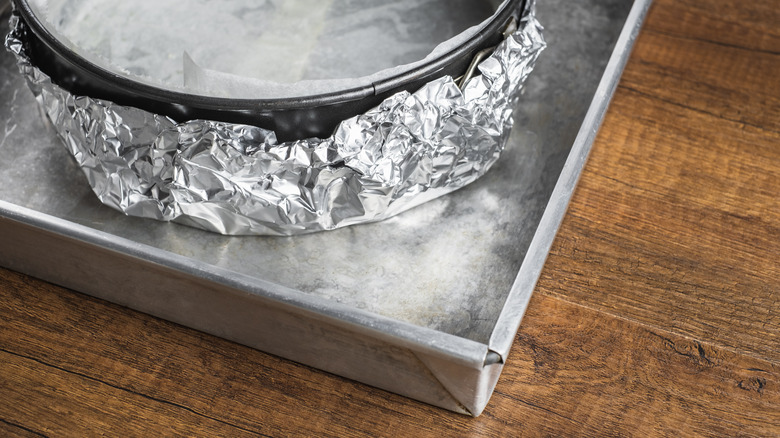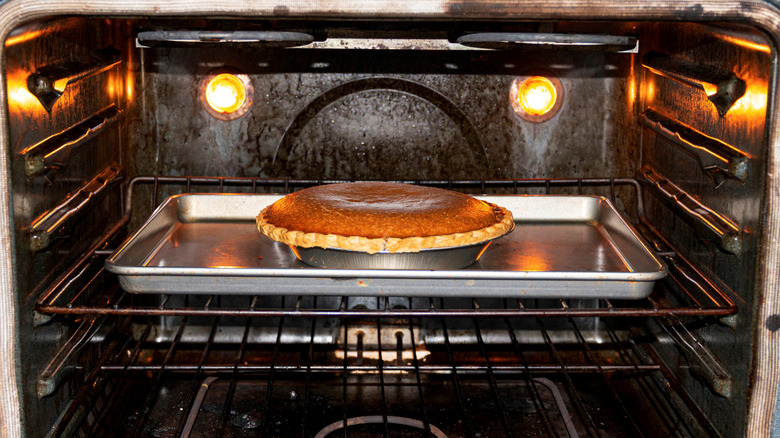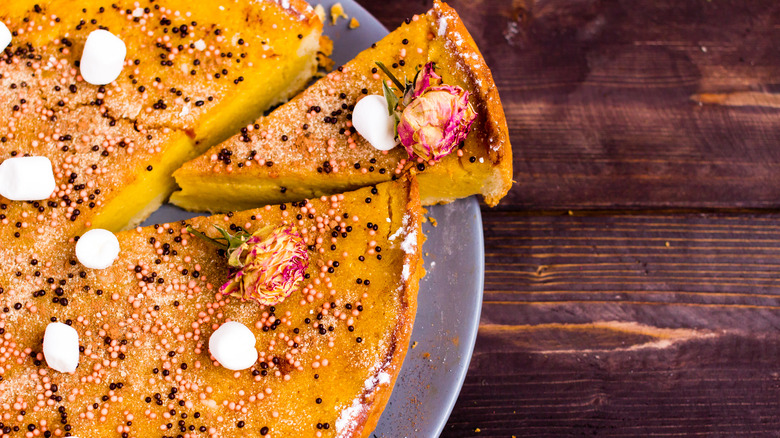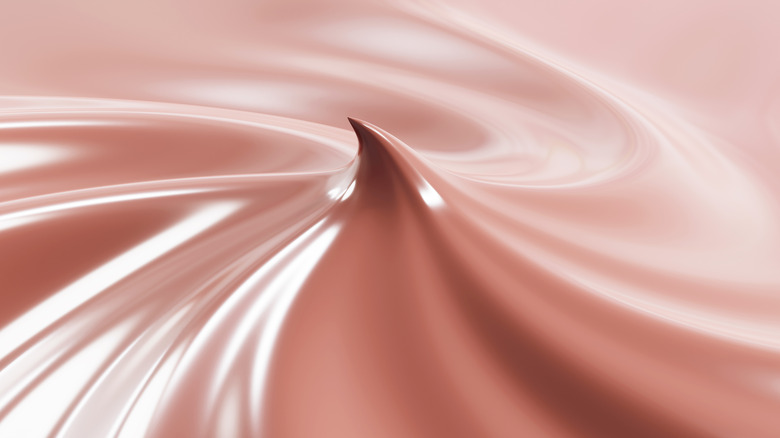14 Expert Tips For Making The Perfect Pumpkin Pie
Pumpkin pie warms us up from the inside out, kind of like an edible hug. This is why, for nearly 18 years as a professional chef, I served dozens of guests a multi-course Thanksgiving menu that almost always ended with a luscious pumpkin pie. But while I generally stuck to the classic recipe, I also played with it here and there, adding a pinch of this or swapping out something for that. In the process, I learned many helpful tips and tricks.
Baking a pie is part art and part science, with certain aspects of the recipe being non-negotiable if the result is going to turn out correctly. From how the crust is prepared to ensuring the filling is flavorful and rich, certain tips and tricks are integral to ensuring dinner guests are going to be treated to the pie they know and love. I'm here to share these insights with you and illuminate the handful of swaps you can make that will give your pie a creative personal twist.
1. Chill the dough in the refrigerator
Whether you make pie crust from scratch or use a store-bought one, one factor can make or break your pumpkin pie: the temperature of the crust. The perfect pie crust — not overly crumbly nor too dense to easily cut with a fork — relies on cold ingredients. The primary elements are flour, fat, and water. These are expertly combined while the ingredients are cold so that the butter remains solid. As these little pockets of butter heat up while the pie crust bakes, they produce steam, which expands, resulting in delicate, flaky layers.
If you notice that your pie crust is beginning to get sticky as you're rolling it out, you should place it back into the refrigerator to cool down. This will ensure that those little pockets of solid butter do not melt, which can result in a less-than-delectable pie crust. Another way of avoiding a sticky crust is to roll it out between two layers of parchment paper, which will prevent your hands from making direct contact with and inadvertently melting it.
2. Infuse the pie crust with different spices
While I don't recommend messing with the proportions of flour, fat, and water in your pie crust recipe, there are a couple of amendments you can make that will jazz things up without adversely impacting the quality of the baked crust. One such adjustment is the addition of the very spices you will likely use in the pie filling. There's no reason for all of the flavor to be in the filling. A teaspoon of pumpkin pie spice, or even just a dash of cinnamon, can provide a hint of complexity to the crust and develop a connection between the two primary components of the pie.
Other potentially fun ingredients to kick your pie crust up a notch are pulverized cookies or crackers. Again, the key is to remain faithful to the proportions of flour, fat, and water indicated in the recipe. In this case, substitute a small percentage of the flour you're using with crushed gingersnaps or even pretzels for added flavor and texture. Just don't go overboard: Too many elements can disrupt the amount of sugar, salt, and even fat in the recipe, resulting in an epic crust failure.
3. Brush the edges of the pie crust with an egg wash
Regardless of whether a pie has a single or double crust, one step can take a lusterless and crumbly pie to brilliant and luscious: brushing it with an egg wash. A quick coating of eggs whisked together with water or milk are all you need to give your dessert character and sheen.
The key is using a delicate touch when applying the egg wash. Too much can result in pooling and pockets of burnt egg, while too little will not yield the intended results. I also prefer using a pastry brush made from natural bristles versus silicone, as I find it to be easier to get even coverage.
While an egg wash is classic, there are alternatives that can be equally effective, including yogurt, sour cream, and even melted honey. Just keep in mind that some of these can easily burn if not diluted with water. When it comes to the perfect pumpkin pie, you want to infuse the crust with color and a hint of richness, without making it overly crisp.
4. Blind bake the pie crust
One of the biggest beefs I have with pumpkin pie is that the crust tends to get soggy under the weight of the filling. A surefire solution to avoiding the dreaded soupy crust is to blind bake it before adding the filling. Blind baking is a fairly straightforward process, involving pre-baking the crust until it is just set and beginning to take on some color. While this seems relatively simple to do, there are some pitfalls to avoid.
First, pie crust will naturally want to puff up as it bakes due to the steam released by those pockets of cold butter. To avoid this, the unbaked crust needs to be covered with aluminum foil or parchment paper and weighed down, using either dried beans or pie weights. This will help secure the crust as it bakes, preventing it from expanding. About halfway through the blind-baking process, the weights and covering can be gently removed and the bottom of the crust docked with a fork before it gets returned to the oven. This will allow the crust to dry out and crisp up before the filling is added and the pie gets finished.
5. Use brown sugar in place of half of the white sugar
When it comes to baking, the difference between white and brown sugar is vast, and the two cannot always be used interchangeably. White sugar is refined and filtered, eliminating any residual molasses. Brown sugar has had some of this molasses added back in, contributing a rich caramel flavor and increasing its moisture content.
Though some pumpkin pie recipes are developed using brown sugar, others rely on white sugar to sweeten the filling. While it may be tempting to just swap the white sugar with brown sugar, doing so may yield a filling that is too dense and moist, which can make your pie soggy. It's best to only substitute half of the white sugar in the recipe and slightly reduce the liquid in the pie filling to accommodate for the increased moisture content of the brown sugar.
When it comes to using light versus dark brown sugar, keep in mind that the amount of molasses and moisture content is higher in the latter. But it's not a notable enough difference to disrupt the texture of the filling. The biggest contrast between the two is in their respective flavors, with dark brown sugar delivering a more robust punch.
6. Create your own pumpkin pie spice
Pumpkin pie spice is big business. The spice blend, originally intended for this quintessential fall dessert, has made its way into everything, from lattes to peanut butter. When it comes to pie, though, the generic combination of cinnamon, ginger, cloves, and nutmeg seems to have lost some of its panache. The remedy for this may be at your fingertips, in the form of a homemade batch of pumpkin pie spice.
The benefit of making your own pumpkin pie spice is that you can create the precise blend you like. If you prefer more cinnamon, have at it. Dislike ginger? Leave it out. Whatever your preference, you can adjust accordingly. If you really want to get fancy, try using different types of cinnamon beyond the run-of-the-mill cassia variety, like the piquant Saigon type, which is sure to awaken your taste buds.
Another advantage to creating your own pumpkin pie spice is that you can get creative with the ingredients. There's no need to limit yourself to the classic spices: Try infusing it with exotic flavors, like cardamom, or even a hint of black pepper for some heat.
7. Swap part of the pumpkin with other squashes
This next recommendation may seem counterintuitive, but trust us: There are a number of root vegetables and winter squashes that have complementary flavor profiles and textures to pumpkin. From yams and sweet potatoes to butternut or acorn squash, many of these earth-grown goodies can easily be added to pumpkin pie filling, thus developing a more luscious and complex dessert.
There is precedent for this, as sweet potatoes are frequently used in pies in the South. Their inherent sweetness, earthiness, and slightly less starchy texture makes them an ideal filling for a pie, whether you use fresh or canned variations. While butternut and acorn squash may be more typically associated with creamy soups or savory pasta dishes, they too have the capacity to confer a richness and nuance to pie, which can elevate even the most sophisticated recipe.
When using hard winter squashes, I suggest roasting and puréeing them in the food processor before incorporating them into your pie filling. This will give them a deep, caramelized, nutty flavor that accentuates the spices and brown sugar. Just remember not to mess with the precise proportions of the recipe.
8. Use canned pumpkin
If you want to know whether there's any notable difference between making a pie using fresh pumpkin versus the stuff you buy in a can, listen up. I have done a side-by-side taste test and can confirm it's not worth the effort involved with fresh pumpkin. A few years ago I obtained pie pumpkins from a local farm. Pie pumpkins are generally smaller than the ones we carve for Halloween. Between cooking, seeding, and mashing the meat, preparing them takes a lot of time and hassle. When I compared a pie baked with the fresh pumpkin versus one made with canned pumpkin, the difference was underwhelming.
That said, be sure that you're using plain canned pumpkin, not pre-sweetened and seasoned pie filling. You can sweeten and season the plain canned pumpkin to your liking, controlling for the amount of sugar and adding more spices to elevate its flavor. If you want even deeper taste and a more luxurious texture, take a hint from celebrity chef Ruth Reichl and roast the canned pumpkin purée before transforming it into a pie filling. This process helps to remove excess moisture and eliminate any hint of vegetal or metallic flavor from the canned pumpkin.
9. Refrigerate the filling overnight
This more obscure trick of the trade requires a little forethought to execute, but the results are well-worth the advanced planning. Before filling your pie crust and baking it, place the prepared filling in the refrigerator overnight. Resting the filling can have transformative results when it comes to both the flavor and texture of the finished pie.
The benefits of refrigerating pie filling are twofold. Doing so allows for the pumpkin pie spice to permeate the filling more completely. While some refer to this as "blooming," this isn't exactly what's occurring. Blooming spices typically involves heating them through before adding them to a recipe, a process which activates the essential oils within them, releasing their aromas and flavors. In this case, it's more like a marination process, using time to allow the spices to infuse all the other components of the filling. Additionally, allowing the filling to refrigerate helps to homogenize it, giving the pie a more uniform texture. This ensures every bite is equally flavorful and creamy.
10. Don't over or under bake your pie
One of the most common issues when baking pumpkin pie is ending up with one that's either over or underdone. An underbaked pie may be loose or weepy, while an overbaked one can crack. While there are a number of visual cues you can use to determine doneness, including color and giving the pie a quick jiggle to see if the custard filling is set and not viscous, these are not always reliable. Neither is simply setting a timer, as every oven is different and factors like ingredients and altitude can alter baking time.
The two most foolproof ways of testing for doneness include inserting a toothpick or paring knife into the filling and employing a digital thermometer. When testing the filling using a toothpick or paring knife, the rules are the same as with any other baking — if it comes out clean, the pie is done. When it comes to a thermometer, most bakers agree that a pumpkin pie is done when it has reached a temperature of 170 degrees Fahrenheit, though the FDA suggests it's only safe to consume when it has reached 180 degrees.
11. Bake the pie in a hot water bath
Some think baking a pumpkin pie in a hot water bath can contribute to a soggy crust, while others swear it's the key to a pie that doesn't crack. I'm in the pro-hot water bath camp. Pumpkin pie filling is essentially a custard. Custards are susceptible to cracking when baked because the heat can cause the eggs to curdle and dry them out. The solution for this is to add some moisture back into the oven in the form of steam, which can be achieved by using a hot water bath, or bain-marie.
A bain-marie involves placing the pie into another pan filled halfway with hot, but not boiling, water. The key to an effective hot water bath when baking a pie is to ensure that the water doesn't spatter into the pie pan. This can be accomplished by using robust aluminum foil and making sure the water bath pan is significantly larger than the pie pan. Additionally, make sure you aren't peeking in the oven too frequently during the baking process. This allows the heat and steam to escape, defeating the purpose of the hot water bath.
12. Cool the pie carefully before refrigerating it
Another common reason that pumpkin pie may crack is that it has not been carefully cooled before refrigeration. As pumpkin pie is removed from the warm oven and transferred to the much cooler kitchen countertop, the protein strands of the egg custard are shocked, causing them to shrivel up. The result is a pie that looks like a glacier in the process of calving.
The solution is to allow the pie to cool in the oven. Once it has been baked, turn the oven off and leave the pie to cool there for roughly an hour. This will allow for the protein strands to temper as they cool and the filling to acclimate, giving the pie a creamy, moist texture. Just be sure to cover and refrigerate the pie within two hours of baking it for safety.
If you're concerned about the crust continuing to brown as the pie cools in the oven, wrap the edges in aluminum foil to protect it. Lastly, take great care with covering your pie for storage. If you lay plastic wrap directly atop the custard filling, it will tear. My favorite storage vessel for a freshly baked pumpkin pie is a cake stand. It protects the pie while leaving it unblemished.
13. Don't be afraid to experiment with the filling
While we've mentioned the pitfalls of disrupting ingredient proportions, this doesn't mean that there isn't room for some creativity and playfulness in your pumpkin pie recipe. What matters most here is keeping the ratio of ingredients and how they're combined consistent. If you do that, your golden — and on your way to some seriously innovative dessert.
Some common ways to elevate the filling of pumpkin pie include sweet add-ins, like chocolate chips, nuts, or toffee chips. The only downside is that they can change the overall texture of the pie, making it more toothsome versus creamy. You can also consider savory elements, which juxtapose the dessert's inherent sweetness with umami in ways that can be seriously tasty. One such ingredient is Worcestershire sauce. Though the secret ingredient in this condiment is anchovies, it's also made with molasses, which can make it blend well with brown sugar and spices if used conservatively. Another umami-forward addition is mushroom powder. Its earthy notes help to temper the heat of the ginger and cinnamon and infuse hints of grassiness that can amplify the squash.
14. Get clever with garnishes
Certainly no pumpkin pie is complete without a garnish. Most often it's topped with a healthy dollop of freshly whipped cream, which not only complements the flavors of the pie, but can cover up any cracks that may form despite your best efforts to minimize their appearance. Though there's nothing wrong with whipped cream, it may be worth investigating the many ways you can take this topping to the next level. From cocoa powder to coffee to peanut butter, the possibilities for transforming whipped cream are virtually endless.
If you want to skip the dairy topping altogether, it may be worth leaning into other flavors that are already making an appearance on the holiday dinner table. One such item is canned cranberry sauce. Its sweet and tart flavor profile is the perfect juxtaposition to a pumpkin pie. The caveat here is that you aren't just plopping the gelatinous sauce over your slice of pie — it needs to be cooked down into a glaze, with the addition of a hint of water or a dash of Grand Marnier. To really jazz this topping up, toss in some dried fruits and chopped nuts for added texture.
